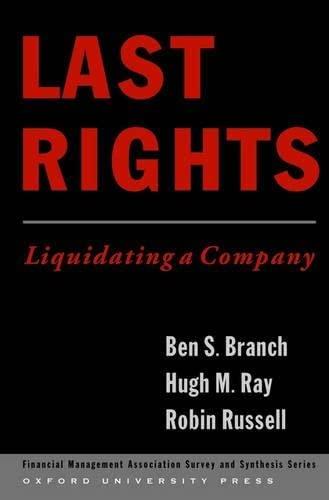Question
21. Should Tangshan Mining company accept a new project if its maximum payback is 3.25 years and its initial after tax cost is $5,000,000 and
21. Should Tangshan Mining company accept a new project if its maximum payback is 3.25 years and its initial after tax cost is $5,000,000 and it is expected to provide after-tax operating cash inflows of $1,800,000 in year 1, $1,900,000 in year 2, $700,000 in year 3 and $1,800,000 in year 4? a. It depends. b. None of the above. c. No. d. Yes.
22. Given the returns of two stocks J and K in the table below over the next 4 years. Find the expected return and standard deviation of holding a portfolio of 40% of stock J and 60% in stock K over the next 4 years: Stock J Stock K 2021 10% 9% 2022 12% 8% 2023 13% 10% 2024 15% 11% a. 14.3% and 2.02% b. 10.6% and 1.34% c. 10.6% and 1.79% d. 10.6% and 1.16%
23. In the capital asset pricing model, an increase in inflationary expectations will be reflected by a(n): Select one: a. decrease in the slope of the security market line. b. parallel shift upward in the security market line. c. parallel shift downward in the security market line. d. increase in the slope of the security market line.
24. When valuing a bond, the characteristics of the bond that remain fixed are all of the following EXCEPT the a. interest payment. b. face value. c. coupon rate. d. price.
25. Tangshan Mining Company is considering investment in one of two mutually exclusive projects M and N which are described below. Tangshan Mining's overall cost of capital is 15 percent, the market return is 15 percent and the risk-free rate is 5 percent. Tangshan estimates that the beta for project M is 1.20 and the beta for project N is 1.40. Project M Project N Initial Investment $700,000 $780,000 Year Cash Flows (CF) 1 $300,000 $220,000 2 $300,000 $320,000 3 $300,000 $380,000 4 $300,000 $460,000 Using the risk-adjusted discount rate method of project evaluation, the NPV for project M is ________. a. $122,970. b. $156,494. c. none of the above. d. $85,732.
26. How much would Sophie have in her account at the end of 10 years if she deposit $2,000 into the account today if she earned 8 percent interest and interest is compounded continuously? a. $4,521 b. $4,317 c. $4,444 d. $4,451
27. Yong Importers, an Asian import company, is evaluating two mutually exclusive projects, A and B. The relevant cash flows for each project are given in the table below. The cost of capital for use in evaluating each of these equally risky projects is 10 percent. Project A Project B Initial Investment $350,000 $425,000 Year Cash Inflows (CF) 1 $140,000 $175,000 2 $165,000 $150,000 3 $190,000 $125,000 4 $100,000 5 $75,000 6 $50,000 The Annualized NPV of project A is ________. a. $38,227 b. $12,947 c. $22,673 d. $21,828
28. You have been offered a project paying $300 at the beginning of each year for the next 20 years. What is the maximum amount of money you would invest in this project if you expect 9 percent rate of return to your investment? a. $ 6,000.00 b. $ 2,738.70 c. $15,347.70 d. $ 2,985.18
29. The amount by which the required discount rate exceeds the risk-free rate is called a. the risk equivalent. b. the excess risk. c. the risk premium. d. the opportunity cost.
30. The future value of $200 received today and deposited at 8 percent for three years is a. $248. b. $200. c. $252. d. $158.
Step by Step Solution
There are 3 Steps involved in it
Step: 1

Get Instant Access to Expert-Tailored Solutions
See step-by-step solutions with expert insights and AI powered tools for academic success
Step: 2

Step: 3

Ace Your Homework with AI
Get the answers you need in no time with our AI-driven, step-by-step assistance
Get Started


